
There’s something truly special about life on the road in Aotearoa – New Zealand. For Toni and me, campervanning isn’t just a way to travel — it’s a way of life. We spend the warmer months exploring in our campervan, discovering hidden gems tucked across the country. Even after all these years, we’re still amazed by the magic we find: quiet freedom camping spots, off-the-beaten-path reserves, crystal-clear swimming holes, scenic walking and biking tracks, and incredible fishing locations. There’s never a dull day — and that’s exactly why we love it.
Aotearoa – New Zealand is a dream destination for international visitors, renowned for its natural beauty, warm hospitality, and unforgettable outdoor adventures. One of the best ways to experience it all? By hiring a campervan. With the freedom to travel at your own pace, wake up beside a remote lake, and stay close to nature, campervanning offers a flexible and immersive way to connect with the land and people of this special place.
Why Choose a Campervan for Your Aotearoa – New Zealand Adventure?
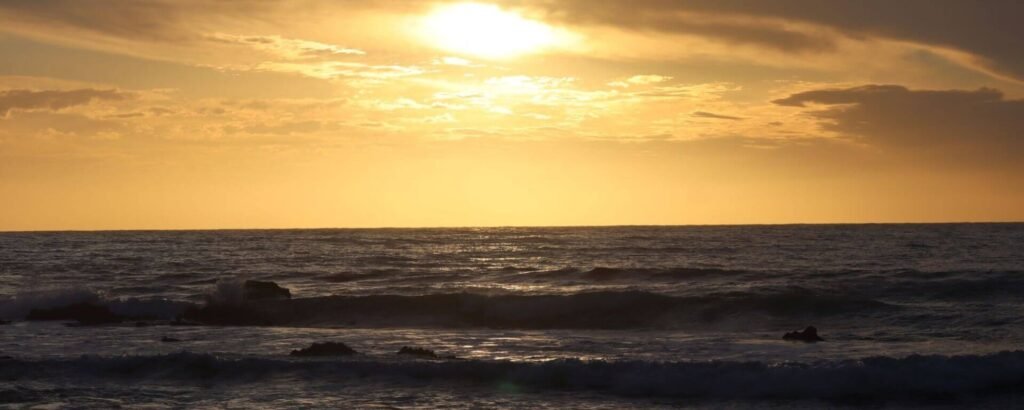
Is campervanning really the best way to explore Aotearoa – New Zealand? For many international travellers, the answer is a definite yes. With breathtaking scenic routes, well-maintained roads, and a huge range of camping options, it’s a travel style that offers freedom few others can match.
Forget tight schedules, pricey hotels, or rigid itineraries — in a campervan, you can follow the sunshine, stay longer in your favourite spots, and go wherever the road leads. It’s the ultimate way to experience Aotearoa – New Zealand on your own terms.
What to Expect in This Campervan Guide for Visitors

In this guide, we’ll share our personal insights and practical tips to help you get the most out of your campervan journey in Aotearoa – New Zealand. From choosing the right vehicle to understanding local road rules, budgeting for everyday costs, and planning for fuel, food, and ferry crossings — we’ve got you covered.
Whether it’s your first visit or your fifth road trip, this guide will help you travel with confidence and enjoy every moment on the road.
Table of Contents
- Why Choose a Campervan for Your Aotearoa – New Zealand Adventure?
- What to Expect in This Campervan Guide for Visitors
- Hiring a Campervan in Aotearoa – New Zealand
- Coastal vs Inland Adventures in Aotearoa – New Zealand
- When to Travel for Coastal and Inland Adventures
- Road Rules for Driving in Aotearoa – New Zealand
- Unique Driving Conditions Across Aotearoa – New Zealand
- Campgrounds and Freedom Camping in Aotearoa – New Zealand
- Safety Tips for Campgrounds and Freedom Camping
- Cost of Travel in Aotearoa – New Zealand: Campervan Journey Breakdown
- Aotearoa Ferry Crossings Between North and South Islands
- Food and Daily Expenses While Campervanning in Aotearoa – New Zealand
- Safety While Campervanning in Aotearoa – New Zealand
- Additional Tips for Campervan Travel
- Navigating Aotearoa Using Google Maps
- A Final Note from the Road
Hiring a Campervan in Aotearoa – New Zealand
There are plenty of options when it comes to hiring a campervan in Aotearoa – New Zealand, with choices to suit every budget, travel style, and level of comfort. Whether you’re after a basic van for a budget-friendly road trip or a fully equipped motorhome with all the bells and whistles, you’ll find something that fits your needs. From compact two-berth vans ideal for couples or solo travellers, to larger family-sized models with onboard bathrooms and kitchens, there’s truly something for everyone. Many companies also offer one-way hires, which is great if you’re planning a longer route across the islands.
Here’s a breakdown of popular campervan hire companies to consider:
Budget-Friendly Options
- JUCY Rentals: Known for their fun, compact campervans with essential amenities, JUCY is a favourite for budget-conscious travellers who want an adventurous, no-fuss way to see Aotearoa – New Zealand. Their colourful vans are instantly recognisable and come with everything you need to enjoy the open road. 🗺️ Hire Locations: Auckland, Christchurch, and Queenstown Airports — perfect for exploring either island.
- Spaceships Rentals: If you’re after something that drives like a car but sleeps like a campervan, Spaceships is a great choice. Their vehicles are compact, fuel-efficient, and surprisingly comfy, offering both self-contained and non-self-contained models to suit your travel needs. ✨ Why it works: Perfect for solo travellers or couples who want a flexible, easy-driving setup to access coastal routes, remote DOC sites, or winding alpine roads.
Mid-Range Campervans
- Britz Campervan: Britz offers one of the widest ranges of campervans in the country — from compact 2-berth vehicles to larger family-sized options. With handy extras like bike racks, child seats, and pet-friendly choices, it’s a great middle-ground for comfort and convenience. 🏕️ Good to know: You’ll find Britz depots in all major travel hubs — Auckland, Christchurch, and Queenstown.
- Apollo Campervans: A well-known name globally, Apollo is a trusted choice for families and couples. Their campervans are designed for Aotearoa – New Zealand’s rugged conditions, with quality fittings, onboard heating, and great storage. 🌟 Highlights: Reliable customer support, smooth booking system, and vehicles that strike a great balance between price and comfort.
Luxury Motorhome Options
- Maui Campervans: Maui is considered the premium choice for those wanting comfort and style on the road. Expect plush interiors, panoramic windows, full kitchens, onboard bathrooms, and large beds — ideal for longer stays or off-grid luxury. 🌄 Perfect for: Travellers wanting a hotel-on-wheels experience in remote national parks or coastal retreats.
- Wilderness Motorhomes: Wilderness takes luxury up another notch with sleek European-designed motorhomes packed with high-end finishes and thoughtful details. They’re designed for slow, scenic travel — letting you enjoy the journey as much as the destination. 🛏️ Standout feature: Spacious living zones, indoor dining space, and great off-grid capability make these a top pick for extended travel.
Coastal vs Inland Adventures in Aotearoa – New Zealand
What makes Aotearoa – New Zealand so special is the sheer variety of landscapes you’ll encounter on your journey. One moment, you might be parked beside a golden beach, watching the waves roll in — and the next, you’re winding through alpine passes or cruising past rolling green farmland that seems to stretch endlessly.
Love the ocean? You’ll find endless coastal drives, dramatic cliffs, and up-close encounters with marine life. Prefer the mountains? Rugged peaks, lush native forests, and wild rivers are calling your name.
The beauty of campervanning in Aotearoa is that you don’t have to choose. You can wake up by the sea one morning and be surrounded by snow-capped peaks the next. Every road leads to something unforgettable — and that’s what makes travelling here so extraordinary.
Coastal Adventures: Sun, Sand, and Scenic Drives
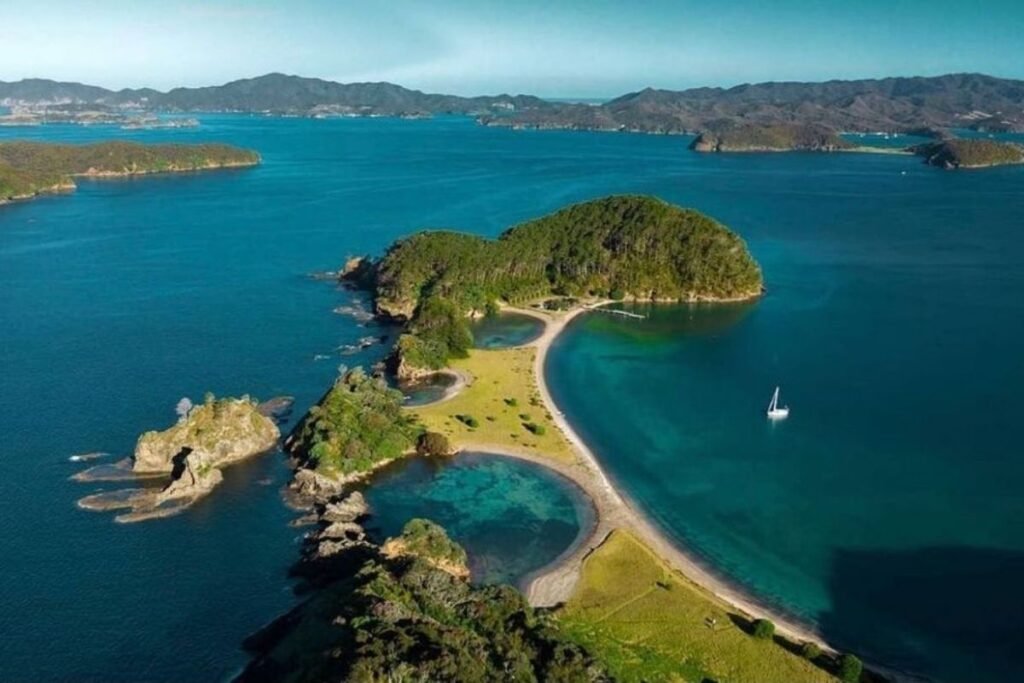
With over 15,000 km of coastline, Aotearoa – New Zealand offers an ever-changing blend of golden beaches, rugged cliffs, sheltered bays, and charming seaside towns. These coastal routes are perfect for those who love water sports, wildlife spotting, or simply soaking in the peaceful rhythm of the ocean. Whether you’re kayaking with dolphins, walking windswept shores, or enjoying fish and chips by the beach, there’s something magical about life on the edge of the sea.
⭐ Coastal Highlights:
- The Coromandel Peninsula (North Island):
Famous for beaches like Cathedral Cove and Hot Water Beach — where you can dig your own natural hot pool in the sand. Winding coastal roads reveal dramatic views and hidden coves. - Bay of Islands (North Island):
A subtropical paradise dotted with 144 islands. Ideal for sailing, dolphin watching, and exploring history at the Waitangi Treaty Grounds. - The Great Coast Road (South Island):
Considered one of the world’s most scenic drives, this stretch features rugged cliffs, lush rainforest, and natural wonders like Punakaiki’s Pancake Rocks and blowholes. - Kaikōura (South Island):
A haven for marine life. Spot whales, seals, and dolphins — then enjoy freshly caught crayfish served up by local vendors.
Inland Adventures: Mountains, Forests, and Epic Trails
Aotearoa – New Zealand’s inland routes offer a completely different kind of magic. From dramatic volcanic plateaus and towering alpine valleys to crystal-clear glacial lakes, these landscapes are wild, powerful, and breathtakingly diverse. It’s the kind of scenery that stirs something deep within — perfect for hiking remote trails, stargazing under dark skies, and losing yourself in the stillness of nature. Whether you’re exploring geothermal wonders or winding through snowy passes, the inland heart of the country offers a soul-stirring adventure of its own.
⭐ Inland Highlights:

- Tongariro National Park (North Island):
A dual World Heritage Site, home to the famous Tongariro Alpine Crossing. This challenging hike passes active volcanoes, emerald lakes, and surreal lunar-like terrain. - Central Otago (South Island):
A rugged region of hills, vineyards, and gold-rush history. Explore scenic cycle routes like the Otago Central Rail Trail and quaint country towns along the way. - Canterbury Plains (South Island):
Flat, wide-open farmland backed by the Southern Alps. An ideal gateway to Arthur’s Pass or Aoraki/Mount Cook National Park.
When to Travel for Coastal and Inland Adventures
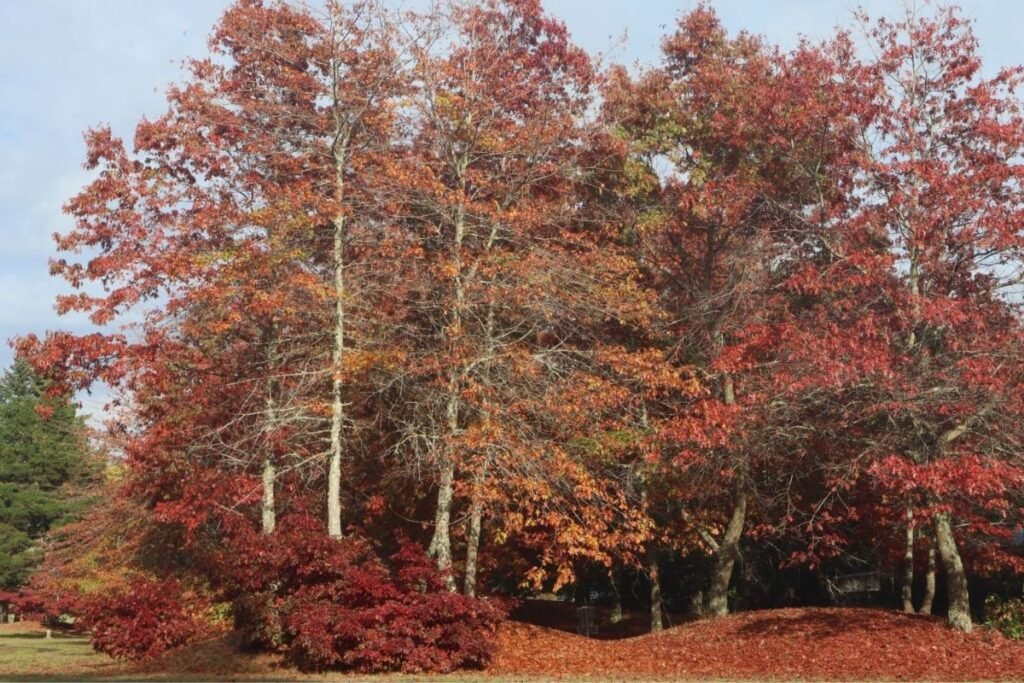
Timing your trip can make all the difference when exploring Aotearoa – New Zealand’s coastlines and inland wonders. Here’s a quick guide to what each season offers:
- ☀️ Summer (December to February):
The perfect season for beach days, coastal drives, and warm inland hikes. Expect longer daylight hours and buzzing seaside towns. - 🍂 Autumn (March to May):
Inland regions like Central Otago and Arrowtown light up with stunning autumn colours. Coastal areas are still warm enough for swimming, kayaking, and evening strolls on the beach. - ❄️ Winter (June to August):
While coastal areas stay relatively mild, inland destinations like Queenstown and Tongariro National Park transform into snowy wonderlands ideal for skiing, snowboarding, or enjoying a cosy mountain retreat. - 🌸 Spring (September to November):
Inland valleys burst with wildflowers, while along the coast, you’ll often spot baby seals, birds, and other springtime wildlife.
Whether you love the sound of waves crashing on the shore or the stillness of a misty mountain pass, Aotearoa – New Zealand’s coastal and inland routes offer something truly special. With a campervan, you don’t have to choose. You can wake up beside a sunlit beach and fall asleep beneath alpine stars.
✨ Let the changing seasons and diverse landscapes guide your journey.
👉 Check out some of our Suggested Routes to help you plan the perfect trip.
Road Rules for Driving in Aotearoa – New Zealand
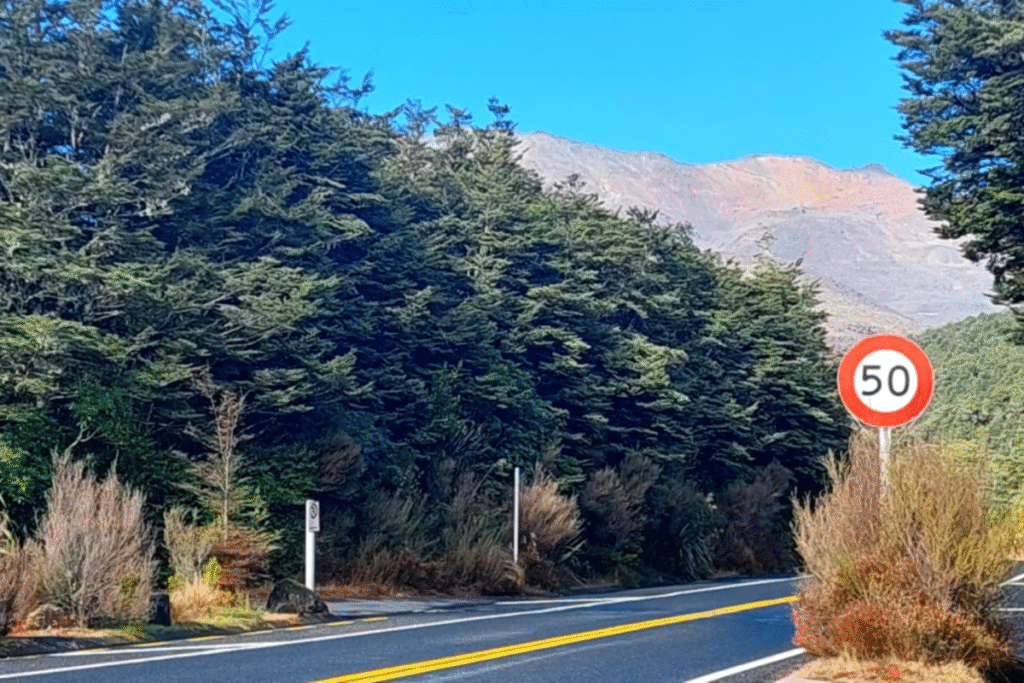
Driving through Aotearoa – New Zealand is one of the best ways to experience the country’s breathtaking scenery, but it can feel quite different from what you’re used to. We know this firsthand — when we drove through Europe, we constantly had to remind ourselves to stay alert. Driving on the opposite side of the road, navigating unfamiliar roundabouts, and adjusting to different rules took a bit of time.
For international visitors coming here, similar challenges can arise. Our roads are often narrow, winding, and pass through small towns with speed zones that change quickly. You’ll also need to keep an eye out for one-lane bridges, steep passes, and fast-changing weather. Staying safe means driving to the conditions, taking regular breaks, and giving yourself extra time.
📌 Key Road Rules to Know
- Drive on the Left:
In Aotearoa – New Zealand, we drive on the left-hand side. Take your time at roundabouts and intersections — it’s normal to feel unsure at first. - Seatbelts Are Mandatory:
Everyone in the vehicle must wear a seatbelt at all times. No exceptions. - Speed Limits:
- 100 km/h on open roads (unless posted otherwise)
- 50 km/h in towns and cities
- Be alert for school zones and town centres where speeds drop to 30–40 km/h
- No Phone Use While Driving:
It’s illegal to use a handheld phone. GPS is fine, but your device must be mounted securely and hands-free.
Unique Driving Conditions Across Aotearoa – New Zealand
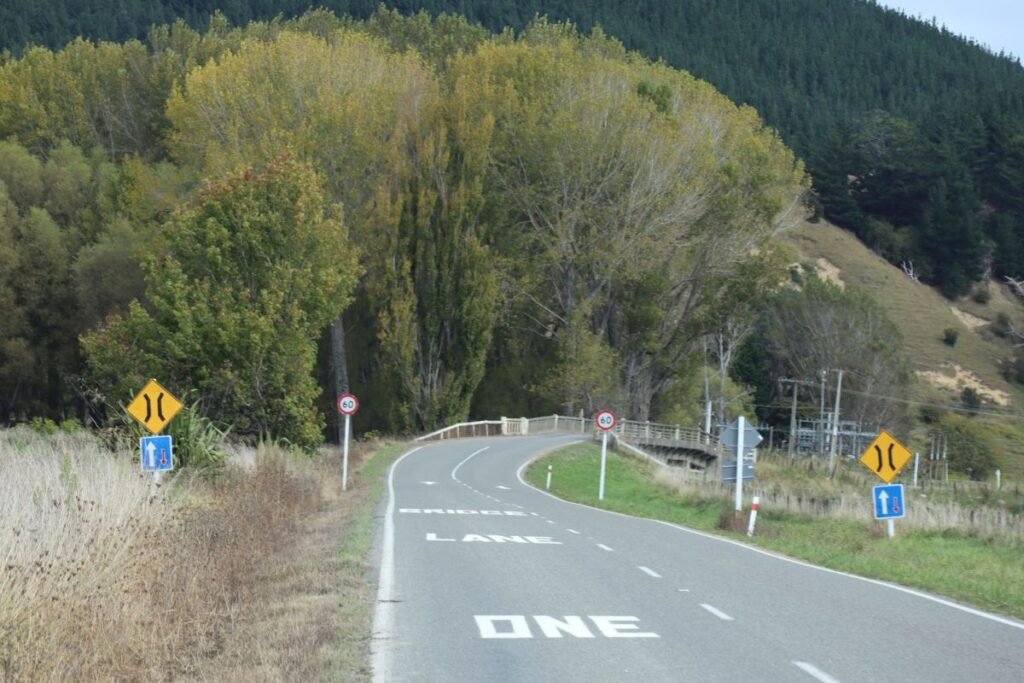
Aotearoa’s landscapes are diverse and dramatic — which makes for amazing road trips, but also throws up a few driving challenges. Here’s what to watch out for:
🪫 Narrow, Winding Roads
Many rural and scenic routes are narrow with sharp corners and minimal passing lanes. Roads like the Crown Range or parts of the Forgotten World Highway require slow, careful driving.
🌉 One-Lane Bridges
Common in remote areas.
- A white arrow means you have the right of way.
- A red arrow means you must give way to oncoming traffic.
Approach slowly and be ready to yield — especially if visibility is limited.
🌧️ Weather-Dependent Roads
- Snow & Ice (Winter):
Roads like Arthur’s Pass and Lindis Pass can be icy or snow-covered. Carry chains when needed and check conditions before you go. - Heavy Rain & Flooding:
Especially in Fiordland and the West Coast. Avoid low-lying roads during downpours. - High Winds:
Common in areas like the Canterbury Plains. Keep both hands on the wheel and reduce speed if needed.
🪨 Gravel Roads
- Some of the most scenic spots — like Skippers Canyon or Cape Reinga — involve gravel driving. Slow down, brake gently, and stay in control. Avoid sudden movements.
⛰️ Mountain Passes
- Haast, Lewis, and Arthur’s Pass all offer jaw-dropping views — and sharp turns, steep drops, and sudden elevation changes. Drive slowly, and don’t be afraid to pull over and let locals pass.
🐄 Livestock on the Road
- In rural areas, it’s normal to encounter cows or sheep on the road — especially near farms.
- Slow down.
- Let the animals pass or follow farmer signals.
- Don’t honk or rush them — they’ll move aside when ready.
We’ve had to wait for cows on the move many times. It can be a bit daunting the first time, but it’s also one of those charming, only-in-NZ moments that you’ll never forget.
Campgrounds and Freedom Camping in Aotearoa – New Zealand
Aotearoa – New Zealand is a campervan traveller’s dream, offering everything from full-service holiday parks to scenic, off-the-grid freedom camping spots. Whether you love the comfort of a hot shower and Wi-Fi or prefer waking up to birdsong beside a remote beach, it’s important to understand the types of campgrounds available — and follow the local rules to keep these special places accessible for everyone
🏡 Holiday Parks
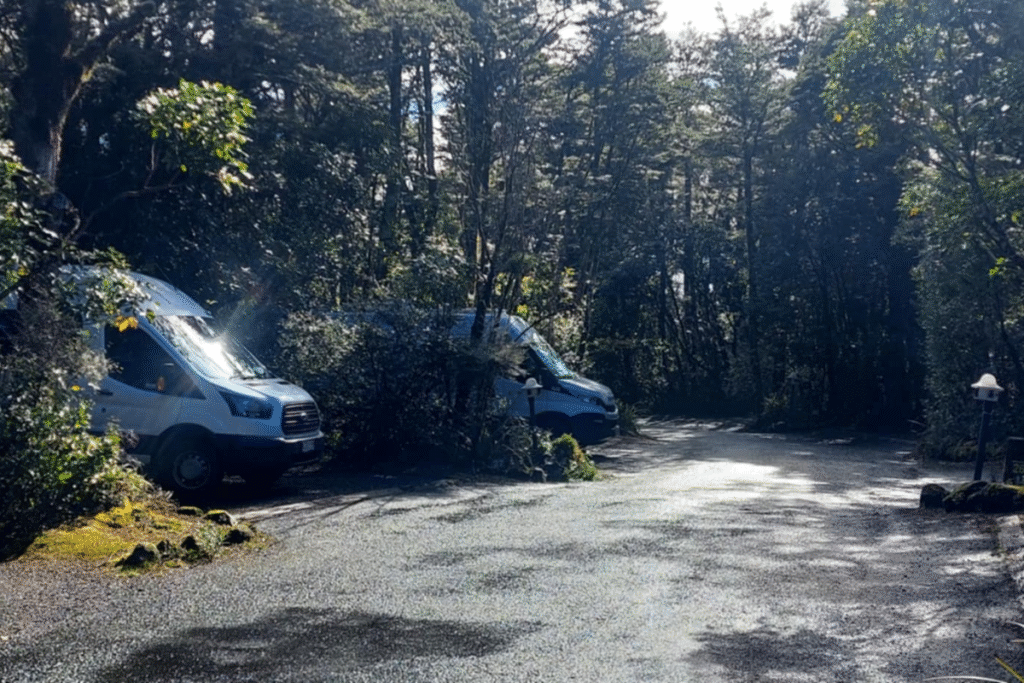
Comfort, convenience, and community.
Holiday parks are a great option for families, groups, or anyone wanting a break from off-grid travel. These sites are fully serviced and located near major tourist destinations — making them ideal for recharging.
- Facilities: Power hookups, hot showers, toilets, kitchens, laundry, Wi-Fi, and sometimes pools, playgrounds, or communal lounges.
- Ideal For: Families, long-term stays, and travellers needing to charge devices or restock supplies.
- Popular Spots: Whakapapa Holiday Park, Queenstown, Rotorua, Kaikōura, Paihia, and Hanmer Springs.
💡 Pro Tip: Holiday parks get busy in peak season (December to February), so book ahead — especially if you need a powered site or are travelling with children.
🌲 DOC (Department of Conservation) Campgrounds
Affordable, scenic, and close to nature.
DOC campsites are some of the most beautiful and budget-friendly places to stay. Found near national parks, forests, and coastal tracks, they’re perfect for travellers wanting to immerse themselves in nature.
- Facilities: Vary from basic (long-drop toilets and water taps) to more developed (shelters, picnic tables, fire pits). Most have no power or Wi-Fi.
- Ideal For: Hikers, nature lovers, and budget travellers seeking tranquillity and easy access to trails.
- Popular DOC Sites: Milford Sound Lodge (Fiordland) – perfect for exploring the iconic fiord. Totaranui Campground (Abel Tasman) – beachfront access, great for coastal hikes and kayaking.
💡 Pro Tip: Many DOC sites are first-come, first-served — arrive early, especially in summer. You can book and pay via the DOC website or app, or pop into the nearest i-SITE visitor centre.
🌿 Freedom Camping
Secluded, flexible, and budget-friendly — with some key rules to follow.
Freedom camping allows you to stay overnight in designated areas (often for free or low cost), but you must have a certified self-contained vehicle with a toilet and waste facilities.
- Facilities: Usually none — though some sites offer public toilets or basic showers.
- Ideal For: Experienced and independent travellers who enjoy remote spots and want to save on camping costs.
- Finding Sites: Use apps like CamperMate, Rankers, or NZMCA to locate freedom camping zones, dump stations, and check reviews.
🚫 Important:
Many towns and regions have restrictions or complete bans on freedom camping to protect nature and manage crowds. Always check for signage and follow local regulations — fines apply for non-compliance.
🛡️ Safety Tips for Campgrounds and Freedom Camping
Aotearoa – New Zealand is generally a very safe country, especially for campervan travellers, but taking a few simple precautions can help you feel even more secure — particularly when freedom camping or staying in more remote areas.
✅ Stay Safe with These Simple Tips:
- Avoid Isolated Spots:
If you’re travelling alone or unsure about an area, choose well-reviewed campsites or locations closer to towns and other travellers. - Lock Up:
Always lock your campervan when you leave it — and at night. Keep windows closed or partially vented if you’re away. - Hide Valuables:
Store things like phones, wallets, passports, and electronics out of sight or in secure compartments. Don’t leave items visible through windows. - Check Weather and Road Conditions:✅ Stay Safe with These Simple Tips:or snow can make certain access roads risky.
- Keep Emergency Info Handy:
Save the local emergency numbers and location of nearby hospitals or police stations. A portable phone charger or power bank can be a lifesaver in rural zones with limited reception.
Whether you stay in the comfort of a holiday park, embrace the simplicity of a DOC campsite, or find your own slice of solitude with freedom camping, Aotearoa – New Zealand offers unforgettable outdoor experiences. With just a little preparation and awareness, you’ll be able to fully relax, wake up to stunning views, and let each evening around the camper feel just as magical as the day’s adventure.
💸 Cost of Travel in Aotearoa – New Zealand: Campervan Journey Breakdown
Aotearoa – New Zealand is not a cheap destination, but a campervan journey offers excellent value when you plan well. It gives you the freedom to explore at your own pace while avoiding hotel costs and expensive tours. Here’s a clear look at the typical costs — with tips to help you make the most of your travel budget.
🚐 Campervan Hire
Cost Range: $50–$300+ NZD per day
What you pay depends on the size, comfort level, and time of year.
- Budget Rentals ($50–$100/day):
Basic vans like JUCY or Spaceships, often non-self-contained, with essential features and minimal extras. - Mid-Range ($100–$200/day):
Self-contained campers suitable for couples or small families. These often include kitchenettes and basic amenities. - Luxury ($200–$300+/day):
Premium motorhomes (e.g., Maui, Wilderness) with full kitchens, showers, heating, and generous living space.
📝 What Affects the Price:
- Season: Summer (Dec–Feb) is peak season. Prices drop from March onwards.
- Rental Duration: Long-term bookings often come with discounted daily rates.
💡 Money-Saving Tip:
Look out for relocation deals — these are heavily discounted one-way rentals where you help a company move a vehicle between cities.
⛽ Fuel Costs
Cost Range: $1.80–$3.00 NZD per litre
(Diesel is usually cheaper than petrol, but includes Road User Charges.)
- Fuel Consumption:
- Small vans: 8–12 L/100km
- Larger motorhomes: 12–16 L/100km
- Typical road trip: 1,500–2,000+ km
💡 Money-Saving Tips:
- Fuel App Recommendation: Download GASBY — it shows the cheapest nearby fuel stations as you travel.
- Fill Up Smart: Fuel is often cheaper in small towns. Avoid topping up in remote or tourist-heavy areas like Haast or Queenstown.
- Diesel Vehicles: Lower per-litre cost but include Road User Charges (RUC), usually $70–$80 per 1,000 km.
🏕️ Campground Fees
Cost Range: $0–$60 NZD per night
Options range from free freedom camping to fully serviced holiday parks.
- Freedom Camping: Free in designated areas for certified self-contained vehicles.
💬 Tip: Avoid highly populated urban sites, which can attract late-night noise or issues. Small-town locations tend to be quieter and friendlier. - DOC Campsites: $10–$25 NZD per night
These offer simple but scenic spots close to hiking trails and natural attractions. Use the DOC website to book and pay online. - Holiday Parks: $25–$60 NZD per night
Fully serviced with power, kitchens, laundry, and Wi-Fi. Great for longer stays or mid-trip recharging.
💡 Money-Saving Tip: Alternate between free and paid campsites. Use CamperMate or Rankers to find top-rated and affordable options.
⛴️Ferry Crossings Between North and South Islands

If you’re planning to explore both islands, you’ll need to cross the Cook Strait — and fair warning, it’s not cheap! Even locals wince at the price. With no real alternatives, costs remain high, especially for campervans.
⛴️Ferry Options
- Campervan + Passengers (Round Trip): $200–$500 NZD
- Prices vary depending on vehicle size, number of travellers, and season.
- Passenger-Only (One-Way): $70–$100 NZD per person
- Ideal if you’re using separate campervans on each island or travelling without a vehicle.
- Ferry Operators:
- Interislander
- Bluebridge
- Both run between Wellington (North Island) and Picton (South Island), with multiple sailings daily.
💡 Money-Saving Tips:
- Book early to lock in better prices — fares rise quickly as departure dates approach.
- Look out for off-peak promotions, multi-trip discounts, or bundle deals.
- Check the weather forecast — ferries are often delayed or cancelled in rough conditions. Always have a flexible backup plan.
Food and Daily Expenses While Campervanning in Aotearoa – New Zealand
Food and activities can quickly become one of the biggest costs when travelling — but in Aotearoa – New Zealand, you can balance unforgettable experiences with budget-friendly choices. Here’s how to manage your daily expenses without missing out.
🛒 Grocery Shopping
Estimated Cost: $100–$150 NZD per week for two people
Shopping at supermarkets is the most cost-effective way to feed yourself on the road.
- Pak’nSave: Cheapest for bulk items
- Woolworths: Wide range, online ordering available
- New World: High-quality produce, slightly pricier
- Four Square: Found in smaller towns; convenient but often more expensive
💡 Pro Tip: Bring reusable bags (plastic bags cost extra) and look for weekly specials to save on staples like milk, bread, and snacks.
🥕Farmers’ Markets, Roadside Stalls, and Butchers
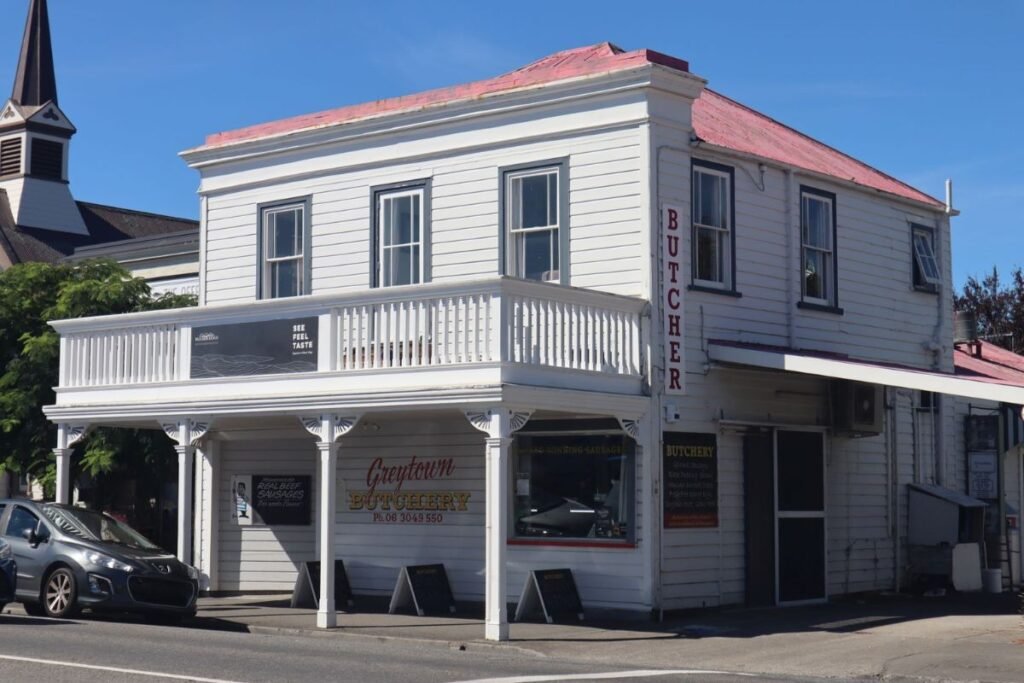
In rural areas, you’ll often spot small honesty-box produce stalls with seasonal fruit and veg — often much cheaper than supermarkets.
- Farmers’ Markets:
Great for artisan cheeses, fresh fruit, honey, and baked goods in places like Nelson, Queenstown, and Hawke’s Bay - Butcher Shops:
Pricier than supermarket meat sections, but often better quality (perfect for BBQs)
💡 Pro Tip: Carry small cash for honesty boxes, and don’t forget to check roadside stalls for avocados, berries, and fresh greens.
🍴Dining Out
Estimated Cost:
- Casual/Takeaways: $15–$25 NZD per person
- Sit-down Meals: $30–$50+ NZD per person
Aotearoa has a vibrant food scene, from food trucks to fine dining.
- Budget-Friendly:
- Food trucks (Wellington, Christchurch, Tauranga)
- Local takeaways: pies, fish and chips, bakery meals
- Splurge:
- Vineyard lunches in Marlborough or Central Otago
- Restaurants in Queenstown or Auckland’s Viaduct
💡 First Table App:
Get 50% off meals by booking early dining slots (typically 5:00–5:30 pm). Great for saving on a night out!
🏞️Free & Paid Activities
Free Adventures:

- Hike the Hooker Valley Track, Mount Maunganui, or Tongariro Crossing
- Visit Piha Beach, Wharariki Beach, Waiotapu Mud Pools, Tokaanu Thermal Walkway or Hot Water Beach
- Explore national parks like Aoraki, Fiordland, or Abel Tasman
- Museums like Te Papa in Wellington (free entry)
Paid Experiences:
- Bungy Jumping (Queenstown, Taupō): $200–$300
- Glacier Hikes (Franz Josef): $350–$400
- Whale Watching (Kaikōura): $150–$200
💡 Tip: Use GrabOne, GetYourGuide (GYG), or Viator to find deals, activity bundles, and seasonal offers.
💰 Smart Ways to Save on Food & Fun
- Cook Your Own Meals: Use your campervan kitchen or communal BBQs at holiday parks
- Pack Snacks: Bring fruit, crackers, and drinks for the road to avoid expensive service station stops
- Visit Free Attractions: Walks, waterfalls, beaches, hot springs — many of the best things in Aotearoa cost nothing
- Plan Ahead: Book activities in advance, travel during shoulder seasons, and keep your plans flexible
🧾 Final Word on Budgeting
Your daily costs will vary depending on your style of travel, but here’s a general guide:
- Budget Travellers: $90–$150 NZD per person per day (self-catering, free activities, freedom camping)
- Mid-Range Travellers: $180–$250 NZD per day (some eating out, DOC campsites, mix of paid/free experiences)
Safety While Campervanning in Aotearoa – New Zealand
Aotearoa – New Zealand is generally considered one of the safest countries in the world, but like anywhere, it pays to stay alert and use common sense. These tips can help you stay safe, avoid unnecessary stress, and make the most of your journey.
🚗 Driving Safety: Stay Focused and Rested
Driving on New Zealand roads — especially after a long hike or on unfamiliar routes — requires extra focus.
- Drive on the left-hand side of the road — this can be hard to remember after a big walk or a long day.
- Rest often, especially after physically demanding activities like the Tongariro Crossing. We’ve seen travellers hop into their vans exhausted and accidentally drive on the wrong side — which can be incredibly dangerous.
- Plan your driving times carefully. Avoid driving late at night or straight after a hike.
- Stay hydrated and alert. If you’re feeling even a bit foggy, pull over for a rest or snack before continuing
🌦️ Be Weather Wise
- Weather in Aotearoa can change fast, especially in alpine areas like Fiordland, Arthur’s Pass, or the central plateau.
- Always check the forecast before heading out — for both your hike and your drive.
- Keep extra supplies on hand in case you’re delayed or conditions turn.
🔒 Protecting Your Valuables
- Don’t leave items like laptops, phones, cameras, or wallets visible inside your campervan — even at scenic stops.
- Carry your passport with you if you’re going far from your van. If you’d rather leave it behind, store it securely and have both digital and physical copies available just in case.
- Park in well-lit areas overnight or when leaving your campervan for longer periods.
- Use common sense — if an area feels off, trust your instincts and move on.
📱 Emergency Numbers & Preparedness
- 111 is the number for emergency services — police, fire, and ambulance.
- Keep a portable phone charger in the vehicle and consider downloading an offline map app like Maps.me or Google Maps with offline areas preloaded.
With a little planning and awareness, you’ll be able to fully enjoy the freedom of the open road. Stay mindful, take breaks, trust your gut, and remember that the best adventures happen when you feel confident and safe.
Additional Tips for Campervan Travel
Here are a few extra tips that can make your campervan journey through Aotearoa – New Zealand smoother, safer, and even more enjoyable.
🧥 Pack for All Seasons
The weather in Aotearoa can change quickly — you might experience sunshine, rain, and wind all in one day. Bring layered clothing, including warm layers, waterproofs, and quick-dry options. It’s all part of the adventure, but being prepared makes a big difference.
📶 Connectivity Isn’t Guaranteed
Mobile reception can be surprisingly patchy in rural, coastal, and alpine areas — even on short drives. We live in the middle of the North Island, and when we visit our grandies (just a 2-hour drive), we only get connection for about 30 minutes total on that stretch.
- Download offline maps in advance (Google Maps or Maps.me)
- Consider renting a mobile Wi-Fi unit if you need reliable access
- Don’t rely on your phone for last-minute bookings or navigation in remote areas
🛡️ Check Your Insurance Coverage
Make sure your travel insurance includes campervan use — not all policies do. Read the fine print and check for common exclusions like:
- Driving on unsealed roads
- Coverage for windscreen and tyre damage (super handy, especially on gravel roads)
- Personal belongings inside the camper
💡 Pro Tip: Windscreen insurance is a smart add-on — loose gravel from roadworks is a common hazard.
📱 Essential Travel Apps
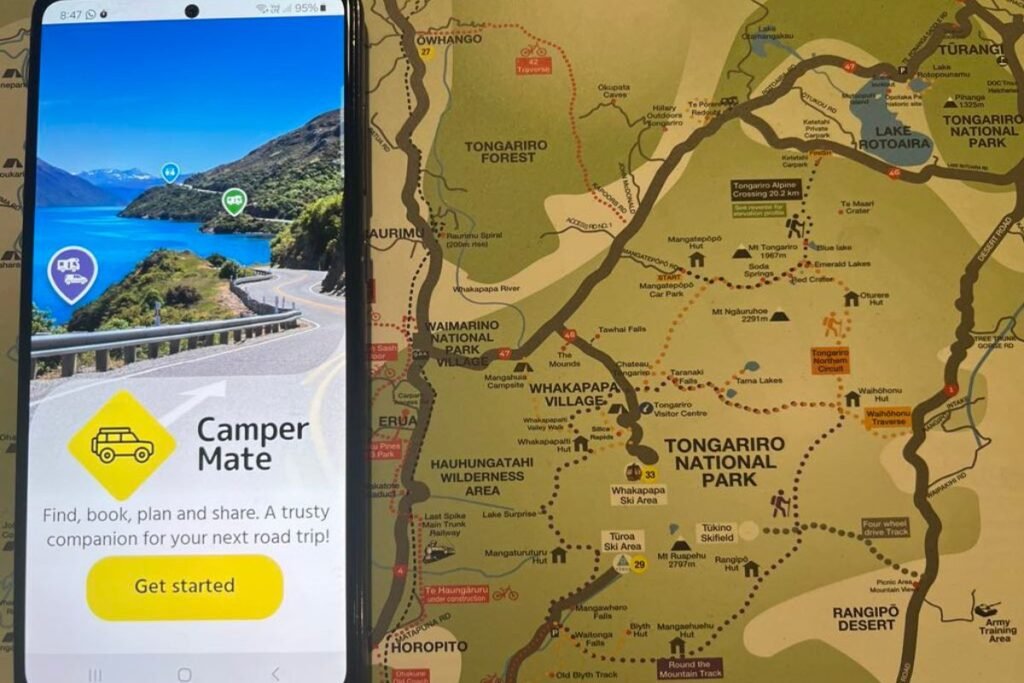
There are some amazing free apps that make campervanning around Aotearoa easier:
- CamperMate: For campgrounds, dump stations, petrol stations, and local tips
- Rankers NZ: Detailed reviews and ratings of campgrounds (even DOC and freedom spots)
- WikiCamps NZ: A great all-in-one guide with offline features
Download these before your trip and keep them handy — they’ll quickly become your best mates on the road.
Navigating Aotearoa Using Google Maps
Travelling through Aotearoa – New Zealand is a breathtaking experience, with winding coastal roads, scenic mountain passes, and charming small towns waiting to be discovered. Reliable navigation is essential — and Google Maps is a fantastic tool to help guide your journey. Still, like any tool, it has its limitations in a country as diverse and remote as ours.
📍 Why We Recommend Google Maps
- Real-time route updates: Helpful in cities like Auckland or Christchurch where traffic can fluctuate.
- Search nearby features: Find petrol stations, grocery stores, cafés, and campgrounds with ease.
- Star favourite spots: Save places you want to visit (or return to!) — great for spontaneous detours.
📶 Offline Maps Are a Must
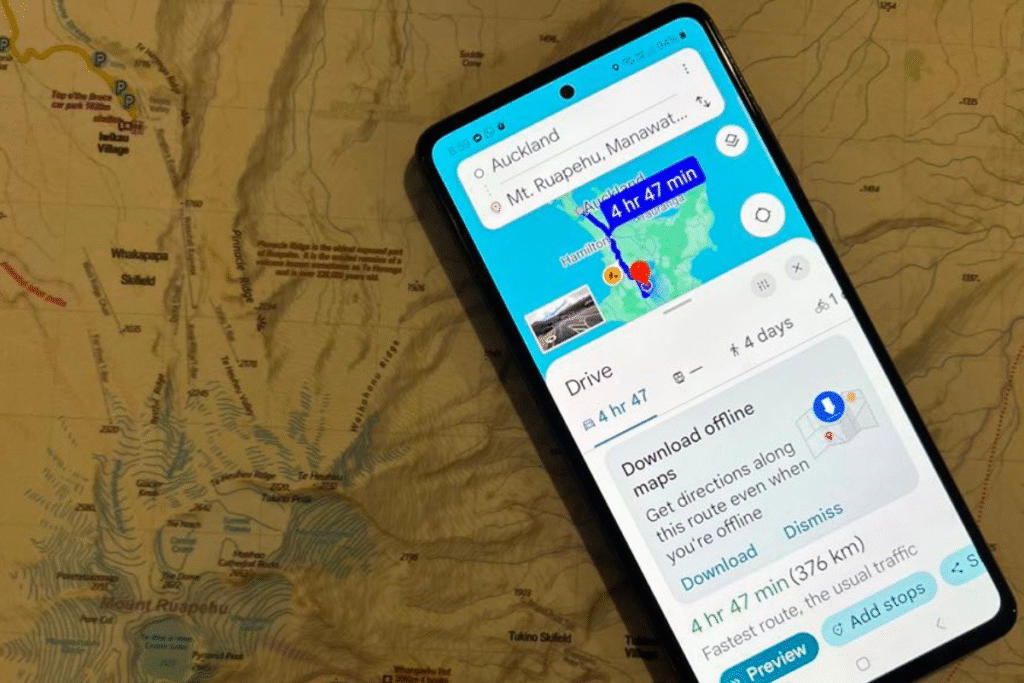
Many parts of Aotearoa – especially in Fiordland, the West Coast, or Arthur’s Pass — have limited or no mobile coverage. If you rely on mobile data, you could find yourself without navigation when you need it most.
💡 Pro Tip:
Download offline maps before you set off. This allows you to:
- Navigate remote areas like Lake Tekapo, Mavora Lakes, or East Cape
- Still access directions, route options, and saved locations — even without a signal
⚠️ Watch for Route Quirks
Google Maps sometimes suggests:
- Unsealed back roads not suitable for campervans
- Private farm access routes or seasonal tracks
🚫 If a shortcut looks too good to be true, it probably is. Stick to:
- State Highways or main marked roads
- Trusted advice from apps like CamperMate or Rankers, which cater to campervans and offer local reviews and updates
🚐 Smart Navigation = A Better Journey
Use Google Maps as your base — but don’t rely on it 100%. Combine it with:
- Offline backups
- Physical maps if going fully remote
- Local knowledge from camp hosts, DOC staff, or fellow travellers
And most importantly, remember: the journey is just as special as the destination. Pull over when something catches your eye — that’s where the best memories are made.
A Final Note from the Road
Toni and I have managed campgrounds across Aotearoa – New Zealand, so we’ve seen firsthand just how many visitors fall in love with campervan life and genuinely appreciate everything this beautiful country has to offer.
Freedom camping is a privilege, not a right.
Respecting the land, local communities, and the facilities provided ensures that future travellers can enjoy the same freedom and beauty you’ve experienced.
Take in the views. Embrace the adventure. And always leave no trace.
Ko te pae tawhiti whāia kia tata, ko te pae tata whakamaua kia tīna.
Seek our distant horizons, and cherish those you attain.